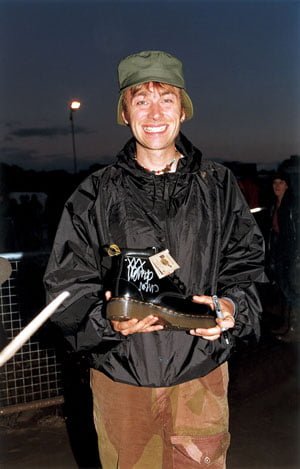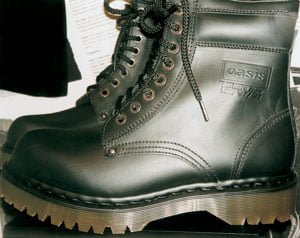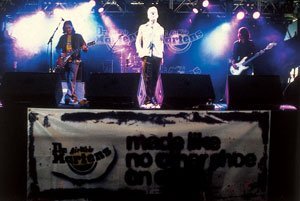
Perceptions are the ways in which consumers see and interpret information about objects such as brands and companies. For example, everyone will have a perception of Coca-Cola, McDonald’s, Marks & Spencer, Dr. Martens and other well known names.
Brands are products with a unique, consistent and well-recognised character. The uniqueness can come either from pure facts about the product or from its image – usually created by its manufacturer through advertising and packaging. For example, you will all be able to identify products which have an ‘old fashioned’ or a ‘modern’ image and ones which have a ‘healthy’ or ‘unhealthy’ image. The consistency comes mainly from the consistency of its quality and performance, but it also reflects the consistency of the advertising and packaging.
Consumers form images of brands and companies based on the overall perception of the product, the marketing information surrounding the product and past experiences with the product. Brand image is very important to companies. Today, people are more brand conscious than ever before and so it is very important for a company to build a brand image which reflects the best aspects of its products.
This case study focuses on a leading brand, Dr. Martens, and examines how it has continued to develop a brand image based on strong associations with youth. The study shows how Dr. Martens has built brand awareness through sponsorship links to music, fashion and theatre and outlines the promotional activities which support these areas.
The origin of Dr. Martens
The Dr. Martens Air Cushion sole was developed in post-war Munich for orthopaedic shoes by Dr Klaus Maertens. The soles were patented and quickly became the top seller in the comfort shoe market in Germany. In 1959, Dr Maertens and his partner, Dr Herbert Funck, set out to find a company to produce their soles in order to export them throughout Europe.
R. Griggs & Company Limited, based in Northamptonshire, was already a manufacturer of the army and work-wear boots with a comfort theme. It began to make footwear with the Dr. Martens sole, which it branded AirWair. The Group’s success in selling the shoes led the partners to licence R. Griggs to make the soles for the rest of the world.
In the late 1960s no teenager with attitude was properly dressed without a pair of eight eyelet ‘Doc Martens Cherry Reds’. The boots, however, were also being bought in their thousands by working people because of their sheer practicality. Today Dr. Martens has become a true icon of youth culture throughout the world.
Fashion marketing

There is little doubt that there has always been a close association between music, style and fashion. Most youth cultures, since Dr. Martens hit the world stage in 1960, have associated themselves with a style of music – ska, glam rock, grunge and punk… Each of these youth movements has been comfortable with Dr. Martens products as part of its look and lifestyle.
Fashion marketing always benefits from the ‘early adopters’ of products, i.e. those who are prepared to lead style and fashion rather than follow others. It is always helpful for marketers if individuals and groups with a strong public following choose to adopt the product being marketed. Many artists wear Dr. Martens footwear and help provide a strong momentum of interest for the brand. The ever-growing list of bands seen wearing Dr. Martens footwear includes Aerosmith, Beck, No Doubt, The Fugees, The Cranberries, Madness, Red Hot Chilli Peppers, The Mighty Mighty Bosstones, Black Grape, Chemical Brothers, Terrorvision, Kula Shaker, The Crocketts, Republica, The Dandy Warhols, David Bowie, Earl Brutus, Audioweb, Dexy’s Midnight Runners, Hanson, Alanis Morrisette, The Undertones, The Sex Pistols, The Who, M People, Sting, Madonna, Nirvana, Oasis and not forgetting Elton John’s giant Cherry Reds specially made for the film ‘Tommy’.
Until quite recently, these artists were to be seen wearing the Dr. Martens core product. However, as the brand has diversified into more and more varied lines, so too has the spirit of adventure of the ‘early adopters’ who today can choose from a wide range of new styles.
Building brand awareness

In creating a strategic marketing plan, an organisation determines its own strengths and weaknesses compared to its competitors and analyses the market environment for opportunities and threats. It can then create objectives and activities to capitalise on market opportunities. A clear strength of the Dr. Martens brand is the statement of individuality it makes. It is therefore a logical step to build on the awareness of the Dr. Martens brand through an association with new bands and artists – the new trendsetters of the day.
Dr. Martens has therefore sponsored a number of leading music festivals around the world, including Phoenix and Reading since 1996 and the legendary Glastonbury festival in 1997 and 1998. The Dr. Martens promotion, entitled ‘The Summer of Music’ can be illustrated by examining its associations with the Glastonbury festival.
Seen as the biggest and the best, tickets for the legendary Glastonbury festival sell out before the band line-up has even been announced! By sponsoring the festival, Dr. Martens was able to secure a number of tickets to use in a ‘register to win’ competition. Nearly 200 Dr. Martens stockists were invited to take part in the planned period of the promotion running from Friday 29th May to Monday 15th June 1998.
The four main areas focused on were:
- win tickets to the festival Entrants were asked to fill in their name and address on the form provided and post the form in the entry box within the store. No purchase was necessary although it was hoped that people would impulse-buy whilst in the store. The promotion enhanced the perception of Dr. Martens and its association with music and encouraged potential customers to enter the store.
- a free gift with every Dr. Martens purchase in this case, the free gift was a pair of Dr. Martens sunglasses – providing an obvious incentive to make a purchase once a prospective customer entered the participating store.
- in-store support

In-store support consisted of an A2 poster and A4 showcard showing the Dr. Martens ‘Summer of Music’ graphic and the Dr. Martens logo and trademarks. These briefly explained the promotion whilst also giving the festival dates and a taster of some of the artists appearing. The national advertising support was consistent in appearance with the in-store support. Full page colour advertisements appeared in the New Musical Express and Select when the promotion first began. The sponsorship of the festival also allowed certain other benefits, such as branding on festival programmes, posters and on-site.
The pattern used at Glastonbury is similar to the approach that Dr. Martens has adopted at other festivals, with some additional extras. For example, on-site branding at the Reading festival included a Dr. Martens stage which was used to showcase new talent (just signed or even unsigned artists). The stage emphasises Dr. Martens policy of supporting youth – up and coming bands such as Kula Shaker, Mansun and Space have all appeared on the Dr. Martens new bands stage.
Dr. Martens is also involved with music sponsorship on a smaller scale – for example, The Barfly evenings at the music venue, The Camden Falcon. The net effect of this activity is that Dr. Martens has become a universally understood and respected brand with ‘opinion formers’ from the world of music, as well as the people that help to make the leading performers what they are.
Sponsorship

Another key area of sponsorship for Dr. Martens is the arts particularly areas of the arts which are associated with young people with ‘attitude’ (i.e. people who have a non-conformist streak to them). Dr. Martens sponsorship is carefully matched to events and approaches which reflect the brand’s key attributes. In 1997, Dr. Martens sponsored the National Youth Theatre’s Summer Season which started with performances at the Edinburgh Festival. One of the productions, ‘Have You Seen This Girl?’ was linked with the housing charity Shelter and Schuh retail stores. Dr. Martens gave £1 to Shelter for every ticket sold for the play and Schuh donated £1 for every pair of Dr. Martens footwear sold in its Edinburgh outlets during the two weeks the play ran.
In addition to Edinburgh, three plays sponsored by Dr. Martens ran in London during September – ‘biloxi Blues’, a female version of ‘The Odd Couple’ and ‘Romeo and Juliet’. Each year, one young member of the National Youth Theatre is approached by an agent to go on (hopefully) to bigger and better things in the world of acting. In 1997, five NYT members were approached and the NYT believes this was a direct consequence of the high profile the Season received as a result of Dr. Martens sponsorship.
The Edinburgh Fringe Festival
In 1998, Dr. Martens sponsored the following productions at The Edinburgh Fringe Festival – ‘Dancing at Luhnasa’, ‘Kissing Angels’ and ‘Dumped’. One of the most exciting projects that Dr. Martens has been involved in is the sponsorship of the Belfast-based Tinderbox Theatre Company. Typically Tinderbox plays to an audience of students and young people with few financial commitments. The company reaches 18-25 year olds in Northern Ireland through a marketing campaign targeted at pubs and clubs.
Tinderbox was recommended to Dr. Martens as a new, young theatre company worth supporting. In 1997, it was producing a new play called ‘Dumped’. The play was about a failed stand-up comic who had been dumped by his girlfriend and who enlisted the help of two people to get his own back. It was, in the words of the press release, a play ‘about love, comedy, vengeance….a play for anyone who had ever thrown out an old sofa or been DUMPED!’
The play opened to rave reviews and Dr. Martens was seen as being at the cutting edge of arts sponsorship in Northern Ireland, winning a major award for its pairing with the theatre company. As part of the sponsorship, Dr Martens agreed to give £1 to the Simon Community, Ireland’s version of Shelter, for every person who went to see the play. The Company found that attendance increased and the sponsorship received widespread coverage in newspapers, TV and radio. Typical audiences for the play were made up of between 50 and 80% of 18-25 year olds. This had the additional benefit of enabling Dr. Martens to communicate with its target audience, building awareness of the Dr. Martens brand. Chris Smith, the Heritage Secretary, highlighted Dr. Martens involvement as an example of how businesses in Northern Ireland should be doing more for the arts. Dr. Martens is now sponsoring Tinderbox’s new play ‘Second-hand Thunder’.
Promotion

Another example of an initiative to raise awareness of the Dr. Martens brand is its association with the musical ‘Rent’. The musical is loosely based on ‘La Boh me’. It follows eight young people living in New York and explores issues such as love, sex, homelessness, poverty, etc. The show won four Tony Awards in 1997 and has received excellent reviews from critics.
The producers of the show were very keen to develop some form of a joint promotion with the Dr. Martens brand, especially as Dr. Martens is mentioned in some of the songs and the cast wears Dr. Martens boots. Dr. Martens recognised the opportunities such an association would present and the show’s content was also perfect for Dr. Martens to underline its support for Shelter. The promotional package put together included the following elements:
- A competition in the ten Shelly stores in London and the Dr. Martens Department Store in Covent Garden. The competition was free to enter, with the first prize being a trip to New York provided by aka – the agency handling the show in the UK.
- A CD of highlights from the show was given as a gift with purchases of Dr. Martens footwear in the eleven stores. It included information about Shelter, Dr. Martens and the show and informed the buyer that money would be given to Shelter. In addition, the CD contained a voucher enabling the holder to receive a discount of £2.50 from the price of a ticket to the show.
- In view of the high profile support that Shelter receives from a wide variety of bands, and because of Dr. Martens close relationship with people in the music industry, it was decided to hold a Gala Charity Performance of ‘Rent’ in May 1998. This event raised funds for Shelter and provided the production with a very high level of PR. Dr. Martens promoted the production extensively in-store – raising £20,000 for Shelter. The success of the promotion is being evaluated on an ongoing basis so that lessons can be learnt which will help to inform ongoing marketing initiatives.
Conclusion

Modern organisations need to look outwards to the communities in which they operate to find the best ways of building effective relationships to create more value for all concerned. As a company with a strong orientation to the youth and fashion market, Dr. Martens has chosen to focus its brand building on projects with which young people can identify. These projects include theatre productions and music festivals and have been particularly successful – not only strengthening the Dr. Martens brand but also, in the case of the theatre productions, helping raise money for charity.
